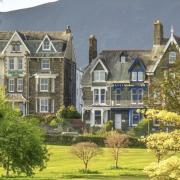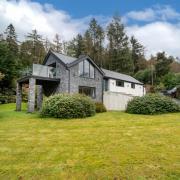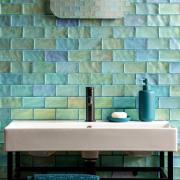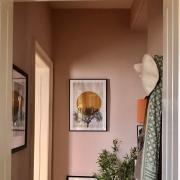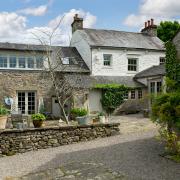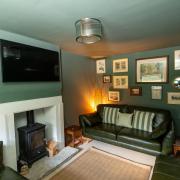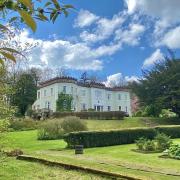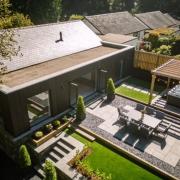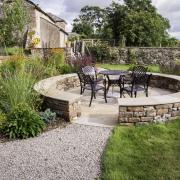A unique Arts and Crafts house near Keswick has been loved by owners who have appreciated its architecture and original features and ensured they have survived for nearly 125 years
There is a road in Portinscale, near Keswick, that is known to many locals simply as The Private Road. It is most desirable, an exclusive enclave where each house is individual and set in its own enclosed grounds with views of majestic fells.
Some properties in New Road, to give it its correct name, were built in the 1960s, others are earlier, classics from the Arts and Crafts era at the turn of the 20th century.

Among them, towards the far end is Lingy Acre, a superb example of the period which happily retains many of the original features of a time renowned for homes of elegance.
Long roof lines, large chimneys, light, spacious rooms, finely crafted features all combine to give the impression of simple and refined rather than grand and ostentatious, yet it does offer more than 5,700sq ft in total.
Lingy Acre dates from 1901, by which time the Arts and Crafts style was well established but still had several years to run.

The land on which it was built, indeed all the lands locally, were originally owned by Lord Derwentwater, a supporter of the 1745 Jacobite rebellion, whose lands were forfeited and held by the Royal Hospital of Seamen, Greenwich.
In 1815 the land passed to T Birkett of Powe House. Later, John Stanwell Birkett, a London solicitor who was born at Yealand Conyers on the Cumbria-Lancashire border, had the idea to create an Arts and Crafts enclave in Portinscale. Whether he inherited the land is not known, but in July 1898 he informed Cockermouth District Council of his plans to create a private road and cover 20 acres with houses. Moss Garth came first in 1898, then High Moss in 1900, a home for Birkett himself, although it was sold by 1904. It is across the road from Lingy Acre, which came in 1901, with four more houses to follow.
Their creation was a triumvirate of John Birkett, architect William Henry Ward and building company Thomas and Isaac Hodgson, of Keswick.

In their book, Arts and Crafts Houses in the Lake District, Matthew Hyde and Esmé Whittaker describe how Ward, the son of a vicar, was born in Buckinghamshire in 1865. He had worked with Dan Gibson – famous for his work in the South Lakes, notably Brockhole – but when Gibson went into partnership with the Arts and Crafts garden designer Thomas Mawson, Ward returned to London as assistant to Sir Edwin Lutyens, famously the designer of The Cenotaph, in Whitehall.
It was there that Ward met John Birkett, who was a trustee and solicitor for the Hampstead Garden Suburb and had those family connections to the Lake District.
Hyde and Whittaker write of Ward’s architecture: “He uses sash windows, not the mullions and transomes favoured by Voysey and Baillie Scott [architects whose work can be found around Windermere]. His houses are roughcast white but he also uses extensive slate-hanging on the exposed elevations.” Both features can be found at Lingy Acre.

Both Birkett and Ward enlisted over-age in the First World War. In a sad end to the collaboration, Birkett was killed and is commemorated in Crosthwaite church, near Keswick; Ward was severely wounded and never fully recovered.
In 1901, Lingy Acre was mortgaged to Misses Fenwick and Alfred Bell, builder. At the time, local valuer Tom Birkett – another of the land owning family? – describes it as being “approached by a good carriage road” and having “charming views of Lake Derwentwater, the wooded slopes of Swinside and Fawe Park and the more imposing mountains of Skiddaw and Catbells”.
“It is somewhat difficult to place a monetary value upon the beauties of nature of which this property commands a good share,” he writes, but notes that the removal of a sycamore tree would much improve the lake view.

At the time, Lingy Acre came with a one third shared ownership of a boathouse on the lake, although this benefit seems to have been lost over time.
“I am of the opinion that the house is well and substantially built and that the internal domestic and sanitary appliances are up to date and of a good class,” adds Birkett on valuing the property at £2,695.
Lingy Acre featured in the January 27, 1912, issue of Country Life magazine in a flowery article headlined, The lesser country houses of today. The writer reflects on Cumberland’s slate as “grey of colour and dour and sharp of texture” compared with the “rich blues and reds and brilliant golds that make the bricks of Kent and Berkshire striking and luminous under the summer sun”.

In Cumberland, properties often have “a weather-worn roof touched with the gold of moss and silver threads lichen merges imperceptibly into the prevailing colour of the countryside”. Buildings’ function is to be unobtrusive in “their splendid setting, and to be clothed in no bright colours that will look bedraggled and unhappy on days of driving mist”.
The writer suggests Mr Ward was swayed by such an idea in designing Lingy Acre. It notes the “restrained and unaffected” outlines and modelling of the building, the plan of the house “straightforward and simple”.
Angled fireplaces enabled all the flues to be gathered into just two chimney stacks, a saving grace, says the writer, that ensures a house “admirably equipped in all ways and not starved in its decorative treatment, can be built for so small a sum as fifteen hundred and seventeen pounds”.
The rest of the article goes on to extol the virtues of installing a service lift, “an excellent device” for taking coals and dishes to the nursery, and presents the argument against electric radiators in upstairs bedrooms, at a cost of £30 for Lingy Acre’s seven – if they went ahead, neither exists now.
The article also examines the costs “for such pleasant things as polished floors and electric devices” – all clearly issues that were occupying the minds of architects and property writers of the day – and includes a handy plan of the interior layout of Lingy Acre at the time.
The Fenwick sisters lived there for more than 25 years, dying within two years of one another in the late 1920s.

Sales particulars from 1929 – it was to be auctioned on April 17 – following the death of the second Miss Fenwick declare it: “This is one of the most perfectly appointed and charming residential properties in the Lake District.”
The view of Derwentwater has by now become only “a charming glimpse” while inside “costly electrical fittings have been installed throughout”. The water supply is of “the purest character and amply sufficient”, there is a “modern system of sanitation” and a telephone is installed.
The entire contents of the residence, including rare carved and inlaid antique and modern furniture in oak, mahogany and rosewood, engravings and prints, silver and other effects, were to be auctioned in the days up to the main sale.
Lingy Acre’s next owner was Sir Joseph Lowrey, then it was occupied by Army personnel during the Second World War.
Later conveyances show Lingy Side and Lingy Bank on either side of Lingy Acre.

Which brings us to its current owners, Keith Graham and Sue Hoffman, who have lived there for exactly 30 years. Thankfully, they have appreciated and thus preserved its Arts and Crafts features.
The porch, described in Country Life as looking like an add-on, offers a practical, covered entry to the front door. It has a slate floor and a period arched opening leading through to the front door, which were typically sturdy and of solid wood or planked in Arts and Crafts homes.
Past the arched side window there is a glamorous cloakroom, which appears on the original plan, off the wide hallway that continues to the main reception hall with an original parquet floor. It is the ideal place from which to admire the staircase with its shallow treads and elegant spindles, and the tall landing windows.

To the right is perhaps the pick of the rooms, a drawing room which, with two bay windows and a feature plaster divide, gives the impression of once being two rooms but was certainly a single space in 1912. It is large enough, therefore, to have two distinct characters: an elegant morning room and a library with herringbone parquet flooring.
The main, low level bay has a window seat and the open fire has a marble surround. It does not require too much imagination to envisage the Fenwick ladies serving tea here to their Edwardian visitors.
Next comes the snug with the ideal proportions for watching TV by the fire before moving into a space that certainly was not here when the house was first built. The orangery was added by Keith and Sue and fills a corner with garden views to three sides. It is sympathetic to the period of the house while providing an ideal entertaining space and much used addition to the downstairs accommodation.

Glass doors open onto one slate terrace with steps to a lower level and the lawn beyond.
It leads through to the dining room, still retaining the original function of the room after almost 125 years and with its slate and marble art deco fireplace on an angle.
The early plan shows the next room as a scullery – which made sense since it is next to the kitchen – but it is now a home office with a pleasant view of the garden. Beyond, the old coal store is a utility room attached to the garage.
Backing onto the dining room, the kitchen also remains untouched in its layout, including the inglenook housing a stove and with the original servants’ bell box. The units, worktops and appliances are, of course, modern. The larder too remains, and the old pantry is a useful boot room happily still with some of its original tall cupboards.
The needs of 21st century families have had more a greater impact on the first floor, to the benefit of residents and guests.

To the left at the top of the stairs, the main bathroom of the earlier home now just serves the third double bedroom. Glamorous and light, it has an art deco style basin in a nod to past times.
The main bedroom is above the drawing room with a corresponding bay window offering a lovely view of the garden and a fireplace. It is a large room so some clever internal joinery for an internal wall has created space behind the bed for a dressing room.
Originally there was another bedroom next door but Sue and Keith had it converted into a large and luxurious en suite bathroom with walk in shower, twin basins and a large oval bath.

All the bedrooms have original doors.
The second bedroom faces the garden and has interesting roof lines and a classic dormer window thanks to a long, sloping roof. Its ‘cottage’ style windows with small panes of glass are classic features of the period. An en suite wet room was added to this bedroom too.
One of the most delightful parts of the property is a second staircase from the landing that leads up to what would have been the servants’ quarters and, likely, the nursery or schoolroom. There is a series of rooms up here, or at least there were, indicated by charming small fireplaces in positions that suggest more than one room, but now it is open plan. A hodge podge of roof lines and a half moon window add to the character.
To the back of the house are more rooms, one of which is a double bedroom with an octagonal window – smaller feature windows were a penchant of the period – and there is a bathroom.

Outside, the gardens are mature and flourishing. There is a double garage at the back with stairs leading up to a gym, and a separate oak framed treble garage.
Lingy Acre is well preserved, clearly loved over the years by people who have owned it. All followers of domestic architecture from the early 20th century will hope it stays that way.
hackney-leigh.co.uk





